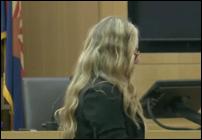Estimated read time: 4-5 minutes
- Jurors in Lori Daybell's Arizona trial viewed evidence including a baseball bat and a pistol.
- First responders testified that there was no physical evidence to show that Alex Cox had performed CPR on Charles Vallow.
- Prosecutors allege Daybell conspired to kill Vallow, using religion as justification.
SALT LAKE CITY — Chandler police officer Daniel Coons testified Tuesday in an Arizona courtroom about multiple items found at the scene of Charles Vallow's death — including the baseball bat Alex Cox and Lori Vallow Daybell claim Vallow used to threaten them.
During Coons' testimony, jurors were shown photos of the inside of the home where Daybell lived in Arizona, including the room where Vallow was shot. The officer said he took photos of the entire house, and over 100 photos were admitted into evidence, including images of Vallow's body lying on the floor and one with a bullet lodged in a baseboard.
Coons said the shell casings at the scene matched a .45 automatic pistol that was also found at the scene. The casings and the gun were in the courtroom as evidence on Tuesday.
Coons talked about the scene and being present for Vallow's autopsy. He said based on the man's two entry and exit wounds, he believes Vallow was shot once while lying on the ground.
Vallow had been shot by his brother-in-law, Alex Cox, the 911 caller who told dispatchers he had begun CPR. Daybell, Vallow's then-wife, is on trial for conspiring to kill Vallow with Cox's help.
Daybell was found guilty in Idaho of murdering her two children — Tylee Ryan, 16, and Joshua "JJ" Vallow, 7 — and conspiring to murder them along with Tammy Daybell, the wife of her current husband Chad Daybell.
Vallow died before Lori Daybell's children were murdered, before Tammy Daybell was murdered, and before Lori and Chad Daybell were married.
Prior to Coons' testimony, Chandler firefighter Scott Cowden testified that he performed CPR on Vallow, who had been shot twice, for about five minutes before it was ultimately determined that Vallow could not be revived.
Though dispatchers told him the 911 caller had started CPR, Cowden, a certified CPR instructor for over 12 years, said it did not appear as if anyone had initiated the lifesaving technique. He went on to explain that Vallow did not exhibit any physical signs — such as an indentation in the chest, broken or cracked ribs, or blood coming out of the mouth — that a typical gunshot victim who had received CPR would show.
Retired Chandler Fire Capt. Kent Keller, who also responded to the shooting, testified that a heart monitor showed Vallow had no electrical rhythm in his heart and that his pupils did not react. He said Cowden performing CPR led to more blood pooling under Vallow's body but that there was no active bleeding because his heart had stopped.
Keller made the decision to end attempts to resuscitate Vallow, saying he believes the man was dead before paramedics arrived and it was unlikely anyone had performed CPR on him beforehand.
On Monday, prosecutors entered into evidence body camera footage from Chandler Police Sgt. Irwin Wierzbick showing what the scene at Lori Daybell's house looked like in the moments after Vallow died.
Wierzbicki testified that Cox was "nonchalant," compliant and "extremely calm" when he came out of the front door of the house. The police sergeant said he found Vallow lying on the ground dead in the front room of the house, a room with no other furniture.
Robert Krautheim, another officer who spoke with Cox outside the home, testified that Cox was calm and "not emotional at all." Krautheim said he noticed a bump or laceration on Cox's head that was "bleeding a little bit," noting that Cox held a mostly white paper towel to his head.
According to Cox, Vallow had hit him in the head with a baseball bat and Cox had shot the man in self-defense.
Krautheim said he also spoke with Daybell and Tylee after they arrived at the home. He described Daybell's demeanor as calm, nonchalant, and "just matter of fact," despite multiple emergency vehicles in front of her house.
In her opening arguments earlier in the day, Daybell, who is representing herself, told jurors that collecting Social Security benefits, having life insurance policies, and acting in self-defense are not crimes.
"A family tragedy is not a crime; it's a tragedy," she concluded.
However, prosecutor Treena Kay cited texts between Daybell and her brother Cox, their actions after Vallow's death, and conflicting stories to explain why the state believes she conspired to kill her husband. Kay said Daybell kept Vallow's phone so he couldn't leave the house, saying she and Cox had planned when Vallow would die, and holding the phone was her role.
Kay said Daybell used "religion … as justification to kill Charles Vallow," citing times she had said that he was possessed by an evil spirit.
Tuesday was the second day of Daybell's conspiracy trial, which is scheduled to last until mid-May.
One juror was excused on Monday for work reasons, and a second juror was excused from her role on Tuesday, with no reason given publicly, meaning there are now 14 jurors — two women and 12 men, Nate Eaton, with EastIdahoNews.com, reported from the courtroom. A third juror was not excused after reporting he was reminded he had seen a YouTube video about the case in the past.
The trial began at 11:30 MST, but the judge ordered a half-hour delay on the livestream. You can watch Tuesday's trial here:
Opening Arguments:













